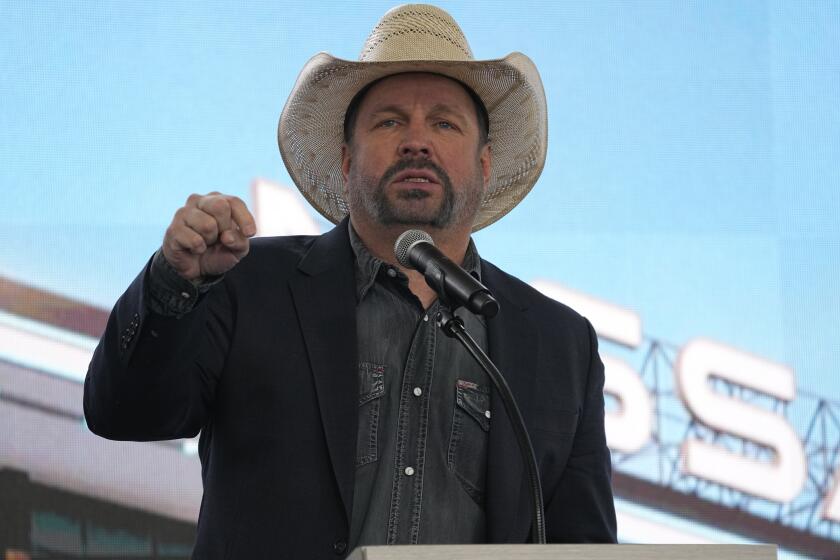Making Hay in the Field of Bluegrass
NASHVILLE — In the fall of 1997, Ricky Skaggs placed himself at a crossroads that changed the direction of his career and his music. As Atlantic Records prepared to issue Skaggs’ next country music album, the Kentucky-born singer and mandolinist asked the record company if he could simultaneously release an all-bluegrass album on an independent label.
Skaggs thought the bluegrass album might help raise his profile. His record sales had slipped significantly in the 1990s, and the onetime million-seller no longer received any significant airplay on the singles he released to country radio.
He hoped the concurrent release of two albums might stir interest in him. Atlantic Records agreed and allowed the move to be made. The result surprised everyone, from country music insiders to longtime bluegrass enthusiasts.
“Life Is a Journey,” Skaggs’ country album, was released by Atlantic in September 1997 and barely sold 20,000 copies. Meanwhile, “Bluegrass Rules!” was released a month later in a joint partnership between Skaggs and the independent label Rounder Records. It sold more than 150,000 copies and received the Grammy for best bluegrass album on Wednesday.
“I am unbelievably overjoyed at what’s happened,” Skaggs says, beaming. Because of those sales figures, Skaggs has left Atlantic and has devoted himself to playing bluegrass music full time again.
For the bluegrass community, Skaggs’ success is just one high-profile example of a growing interest in the traditional American musical genre, which was founded in the 1940s when the late Bill Monroe formed his famed Bluegrass Boys band, which included Earl Scruggs on banjo and Lester Flatt on guitar and vocals.
With Skaggs now fully back in the bluegrass fold, he has joined singer-fiddler Alison Krauss as one of the leading young proponents of the genre. But if Skaggs and Krauss are the modern-day king and queen of bluegrass, the dominion they rule is bigger and healthier than it has been since the early 1960s, when bluegrass’ popularity spread beyond the Southeast as part of the folk-music boom.
Dan Hayes, executive director of the International Bluegrass Music Assn., characterizes the late 1990s as “a particularly golden time in bluegrass music history,” adding that there is more good talent playing to larger audiences and selling more albums than at any time in recent history.
Besides Skaggs’ recently released album “Ancient Tones,” the bluegrass community will be watching closely the reaction to two other just-released collections: the Del McCoury Band’s “The Family” (on Skaggs’ Ceili Music label) and Steve Earle’s collaboration with the McCoury Band, “The Mountain” (on Earle’s own E-Squared label).
Earle’s album is certainly the most surprising and talked-about bluegrass entry since Skaggs’ return to the fold a year and a half ago.
“The Mountain” pairs Earle with the most awarded bluegrass group of the ‘90s. The acoustic album features a drum-less band, built bluegrass-style around mandolin, fiddle, banjo, acoustic guitar and stand-up bass. All the songs were written by Earle, who penned most of them with the McCoury Band in mind.
In their way, the three high-profile albums by Skaggs, Earle and the McCoury Band are decidedly distinct from one another. Skaggs and Kentucky Thunder’s “Ancient Tones” collection looks backward by largely drawing on mountain music classics originally performed by such bluegrass patriarchs as the Stanley Brothers, Flatt & Scruggs and Bill Monroe. Rather than calling on nostalgia, though, Kentucky Thunder plays the songs with a dynamic intensity that highlights the timelessness of the music.
On the other hand, Earle’s “The Mountain” features original songs written by the singer-songwriter, who further displays his mastery by both perfectly mimicking archetypal bluegrass tunes (“Carrie Brown”) as well as expanding the genre to take on new topics and influences (“Paddy on the Beat”). By coincidence, both Skaggs and Earle wrote a new instrumental with a reference in the title to Connemara, a scenic rural area in western Ireland.
The Del McCoury Band straddles Skaggs’ classicism and Earle’s forward progress. By combining a stunning vocal workout on the classic bluegrass gospel song “Get Down on Your Knees and Pray” with a bristling version of the pop oldie “Nashville Cats” and stellar new songs, McCoury pays respect to the past while casting an eye to the future.
“Bluegrass has been a component of my music for as long as I’ve been making records,” Earle says, pointing out that one of his country-rock hits, 1988’s “Copperhead Road,” was what he calls “a heavy-metal bluegrass song.”
Still, bluegrass players tend to be conservative and fundamentally religious. That makes Earle, 44, who spent time in jail in 1995 on drug charges, an unusual figure to be leading a commercial revival in bluegrass.
Earle recognizes that he may be seen as an outsider. “This won’t be my last bluegrass record,” he says, “unless I’m tar-and-feathered at some bluegrass festival this year.”
*
If Earle is viewed as a convert to bluegrass, Skaggs, also 44, was raised in it.
A former bluegrass prodigy who joined Ralph Stanley’s Clinch Mountain Boys band when he was 15, Skaggs parted with the bluegrass world in 1981 when he signed with Columbia Records and began making mainstream country albums.
Initially, he succeeded enormously. He became a leader of country’s back-to-basics movement in the early ‘80s, winning a Grammy and country music’s most prestigious honor, the Country Music Assn.’s Entertainer of the Year.
But with the advent of Garth Brooks, Shania Twain and the “power country” movement of the ‘90s, Skaggs and traditional country music fell from favor. That bothered him, of course, until he found his way back home to bluegrass and once again found himself at the head of a back-to-roots musical movement.
“If I’d have kept having No. 1 hits and successful records, I probably wouldn’t have thought to leave and go back [to bluegrass],” Skaggs says. “But as far as I’m concerned, it couldn’t have worked out better. I’m so happy with what I’m doing. I’m fulfilled in every way.”
While sales are sometimes hard to track because so much bluegrass is sold at the proliferating festivals and through mail-order catalogs, Hayes contends that the music is enjoying greater album sales than at any other time in bluegrass history.
And what about newcomers such as Earle?
Hayes acknowledges that some members of the bluegrass community might be wary of the erstwhile country-rocker and his motives.
“There are those who are protective of the image of bluegrass as a family-style music, and they may wonder what’s going on and why this person is doing this,” he says. “But bluegrass people are more open-minded than they’re given credit for.
“In Steve’s case, I know his love and respect for the music is genuine. Once the fans see that, he will be welcomed and embraced. If it was perceived that he was doing it for anything other than heartfelt reasons, he indeed might be tarred and feathered. But when they see him play with the McCoury Band, they’ll understand quickly that he is coming at it from the heart.”
Earle, for his part, believes the influence of bluegrass music reaches far beyond those choosing to play the music full time.
“The thing I think is important to understand is that all these kids in bands like Son Volt and Marah, they all listen to bluegrass a lot,” Earle says. “They all know who Del McCoury is. And they all identify with it directly because they realize instinctively that bluegrass is the original alternative to commercial country music. It is the original alt-country music.”
As for a pending bluegrass boom, Earle is cautious not to overstate the case.
“It’s important not to overestimate an anomaly,” he says of the concurrent bluegrass releases of Skaggs, the McCoury Band and himself. “But I do believe one thing: Bluegrass music will last, one way or another. That’s the way bluegrass is--people will always be drawn to it, because it’s the real thing. The record I just made might not be my biggest seller. But it will always sell, and I’ll always be able to pay alimony with it, because there will always be a market for bluegrass music.”
More to Read
The biggest entertainment stories
Get our big stories about Hollywood, film, television, music, arts, culture and more right in your inbox as soon as they publish.
You may occasionally receive promotional content from the Los Angeles Times.










